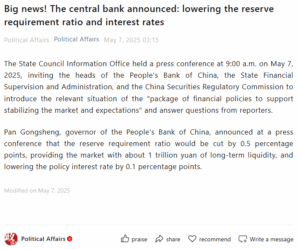
While this might seem like a domestic monetary tweak, the ripple effects could reach far beyond China’s borders, especially into the crypto industry.
For crypto investors and newcomers alike, these shifts signal a new chapter in global capital flows and risk appetite. Understanding why central bank decisions like these matter is key to navigating today’s fast-moving digital asset markets.
Liquidity Is Fuel—and Crypto Is a Risk-On Asset
The reserve requirement ratio is the percentage of deposits that banks must hold in reserve. Lowering it frees up capital, encouraging more lending and investment. Combined with a lower policy rate—essentially the cost of borrowing for financial institutions—this move by the PBoC is designed to jolt economic growth.

Source: weixin.qq
Historically, such liquidity injections have boosted demand for risk-on assets like tech stocks and cryptos. Bitcoin surged over 100% in 2023 during a period of global rate cuts and quantitative easing. More money in the system tends to flow into higher-yield, speculative assets, and crypto fits that bill perfectly.
According to CoinShares, digital asset investment products saw $2.9 billion in inflows during Q4 2023, coinciding with central banks signaling a dovish turn. If China’s latest move inspires similar actions across Asia or influences investor sentiment globally, it could reignite interest in crypto markets, particularly in Bitcoin, Ethereum, and large-cap altcoins.
Boom. Breaking news: China to cut a series of rates:
Reserve ratio requirement by 0.5ppt
7-day reverse repo to 1.4% (from 1.5%)
Structural tools rate by 0.25 pptFutures gap higher ahead of open, minutes away pic.twitter.com/1JpRi57mVp
— David Ingles (@DavidInglesTV) May 7, 2025
China’s Role in Crypto: Complicated but Crucial
While China has taken a hard line on retail crypto trading and mining, its broader economic policies still impact the global digital asset ecosystem. Hong Kong, for instance, has positioned itself as a regulated crypto hub—arguably with Beijing’s tacit approval. A more liquid Chinese economy could mean more capital flowing through these regulated on-ramps. Here is an example:
HONG KONG NOW OFFICIALLY ACCEPTS #BITCOIN AND CRYPTO AS PROOF OF ASSETS TO APPLY FOR RESIDENCY
CHINA IS GETTING PREPARED
pic.twitter.com/ifOB1tU11Z
— Vivek
(@Vivek4real_) February 8, 2025
Additionally, Tether (USDT)—the largest stablecoin by market cap—is heavily used in Asia, including among Chinese-speaking trading communities. A surge in liquidity may increase USDT activity on exchanges, signaling higher trading volumes and volatility in the months ahead.
Disclaimer
The information discussed by Altcoin Buzz is not financial advice. This is for educational, entertainment, and informational purposes only. Any information or strategies are thoughts and opinions relevant to the accepted risk tolerance levels of the writer/reviewers, and their risk tolerance may differ from yours. We are not responsible for any losses you may incur due to any investments directly or indirectly related to the information provided. Bitcoin and other cryptocurrencies are high-risk investments, so please do your due diligence. Copyright Altcoin Buzz Pte Ltd.
The post China Injects $1T Liquidity—What It Means for Crypto? appeared first on Altcoin Buzz.



